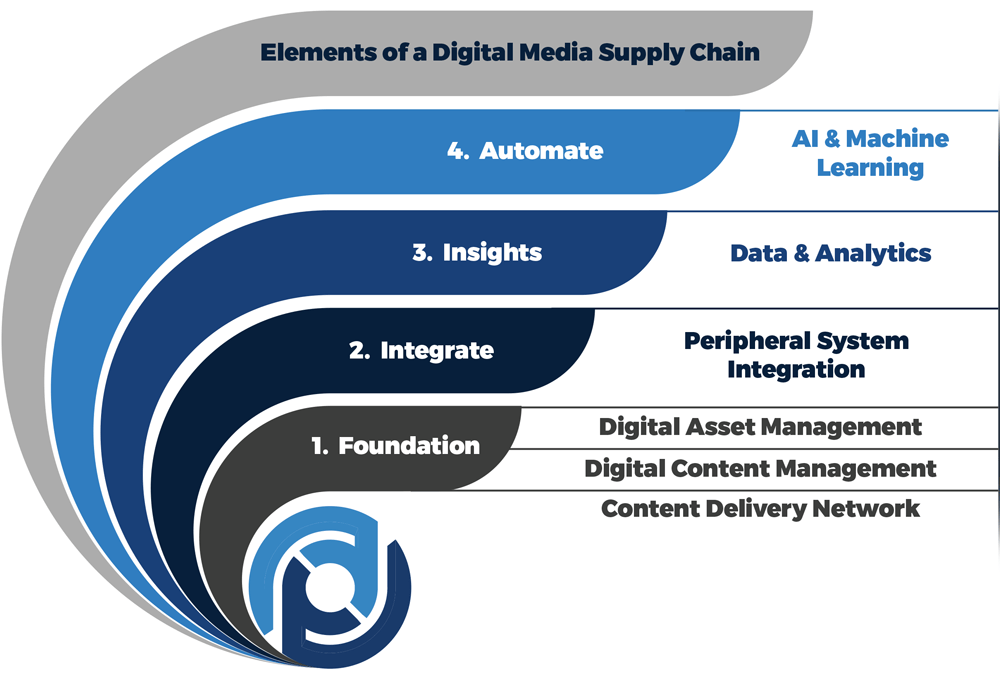Digital media supply chain has long been the lifeblood of Media and Entertainment. Now, with the average adult spending 11 hours a day consuming digital media, other industries are realizing how critical it is to build a digital media supply chain — one built on best-in-breed technology, to get better content to customers faster and enable near real time decision making.
Including time spent sleeping, nearly half of the average American adult’s day — 11 hours[1]— is devoted to consuming digital media supply chain content. Streaming video, social media, video games, smartphone apps: the ways we watch, listen and read grow every day.
Digital media, once something only media and entertainment (M&E) companies were concerned with, is now a prime focus across industries. For marketing organizations in particular, digital transformation has become an unavoidable catchphrase, implying that if you don’t stay on top of how you manage and use content, particularly in the cloud, you risk falling behind in the market.
Every industry today is concerned with digital marketing and looking for optimized ways to manage the creation, sharing and use of digital content. This is what M&E companies call their digital media supply chain. That means adopting tools and processes that work together to enable deeper, more efficient, fluid use of marketing assets across campaigns.
Managing global marketing efforts requires strategic guidelines to enable effective collaboration throughout the asset creation, media planning, buying and placement stages. This requires purpose-built platforms that are integrated to provide corporate oversight or facilitate processes which in turn would bring greater efficiencies and insights through these processes.
There are numerous components to a highly functioning digital media supply chain, and we will cover the foundational elements that all organizations should have as well as what those enable for more advanced organizations.
The Foundation of Your Digital Media Supply Chain
Companies today probably already have some elements of a digital media supply chain without even realizing it. Digital asset management (DAM), digital content management and content delivery networks are the foundational elements you need to have in place in order to build strong digital media supply chains.
Digital Asset Management
With the average enterprise in possession of terabytes if not petabytes of digital media, finding efficient ways to store, manage and surface all those assets is critical. Traditionally, marketing organizations relied upon external agencies to store and manage creative assets, creating extra layers of effort when attempting to retrieve content. Without an efficient DAM tool, most usable content is destined to languish in obscurity or result in convoluted, painful retrieval processes. Furthermore, to move a new piece of content from ideation through approval can be time consuming and expensive.
A DAM system, coupled with a DAM governance process, helps to provide a centralized asset repository and system for holding, finding and collaborating on content assets. DAM takes content ownership “in-house” so asset protection is stronger and self-service functionality, machine learning and automation can be enabled. Surfacing content to use in marketing campaigns and other initiatives becomes a much faster process.
Digital Content Management
Actually getting that content in front of customers and consumers requires another step: digital content management. What was originally referred to as content management when websites were the main point of focus has now evolved to distribution to other end-content consumption points (e.g., YouTube, Netflix, Facebook, Instagram). Various digital content management tools help deliver finished content to its intended use — websites, social media, digital advertising campaigns — and optimize and manage the message your customers see.
Then there’s the matter of how fast they see it.
Content Delivery Network
Google recommends that websites be optimized to load within three seconds. Any longer, and at least 53% of visitors will leave a page.
For enterprise organizations with global presence, a content delivery network (CDN) ensures that content is immediately accessible to dispersed end customers. A user curious about your product line can just as easily view your website in Japan as in Texas. This is made possible by a geographically distributed network of proxy servers that hopscotch content around the world in order to circumvent bandwidth issues. The CDN ensures that your business can deliver content quickly and at scale even in times of heavy regional traffic.

The Customer Focused Future
DAM, digital content management and a content delivery network — these are the foundational elements that allow you to find, use and deliver content more efficiently. But to get true value from your digital media supply chain, these tools need to easily integrate with your other best-in-breed systems. And today, you must also consider how you can derive data, apply automation and even leverage artificial intelligence from and with your digital content.
Today’s marketplace for digital content supply chain platforms and tools is dynamic. Companies that have the vision and motivation now have unique opportunities to start gaining control of all their marketing assets at a global, regional and local level.
Marketing organizations are also entertaining ideas of bringing more services internal — investing in data scientist, in-house creative and media departments, for example — all with the intent of creating better content experiences for customers via increased delivery of content and more precise placements.
A clear understanding of asset lifecycle and each user’s role in it helps manage expectation and establish trust between participants, as well as creating more focused and purposeful activities throughout the operation. These elements empower appropriate users with greater insights and a strategic advantage over today’s environment
System Integration from Asset Creation to Customer Interaction
From asset creation tools (e.g., InDesign, Photoshop) through to customer experience and other MarTech platforms (e.g., Eloqua, Marketing Cloud, Pardot), system integration allows you to share assets, data and insights between and across platforms.
Integrating your DAM with your digital content management system, for instance, allows you to find the digital assets you need and plug them directly into marketing sites and other end uses. Microservices are integral to this integration effort, as they provide discrete web services around your core business and technology functions (e.g., search, accelerated file transfer, content rights) that can be used together as building blocks and scaled independently to handle your content growth.
Managing digital assets at scale such that appropriate product and project metadata persists throughout the entire marketing process presents the single largest opportunity to establish an efficient and effective production, promotion and reporting environment. Leveraging this metadata, managed processes can facilitate or automate mission-critical tasks, adding value at each stage.
Through integration between the planning, creative, placement and reporting tools, your DAM should be able to present users with a unified, real-time environment through which more informed decisions can be made. The key is establishing the usage of unique IDs at the product, campaign, project, asset and placement levels.
Data and Analytics
With the plethora of digital systems out there, getting business value from each system no longer means just using the basic functionality within each system to its fullest, but leveraging all the data and analytics captured by each one of them as well. By integrating systems with each other, this also opens up the opportunity to start tying your various data sources together.
For instance, through integrations of your foundational systems with other systems such as Product Information Management (PIM) and Marketing Resource Management (MRM) systems, you can start seeing relationships between the data to determine insights such as how a specific product’s marketing campaign is performing based on the creative assets that are being used, or the time and cost to create a particular campaign versus the actual usage and effectiveness of the creative assets.
Regardless of the specific tool sets used for planning, DAM, cost tracking and placement, these relationships need to be explicitly maintained throughout your ecosystem in order to achieve the functional integrity necessary to build an effective future state. The data and analytics architecture should support various solutions as customers, systems and partnerships evolve.
Ultimately, all the various insights can start helping you to not only understand your team and content effectiveness, but also create richer and more personalized digital marketing content for your customers.
Machine Learning and Artificial Intelligence (AI)
Tying together your data and analytics from the system integrations with machine learning and AI can give you the power to make an even larger impact. M&E companies have been using machine learning and AI to streamline content processes for a while. For instance, several of the major entertainment studios leverage these tools to recognize faces and objects across videos and still images, in order to tag those descriptors as metadata. Such AI-produced metadata compliments traditional metadata entry, gives companies insight into their content and takes much less time to implement compared to manual tagging efforts.
Now, other industries are tapping into the value of using machine learning to automatically tag their digital assets as well. In retail, for instance, metadata automatically applied to product shots makes it easier to find and create marketing assets from catalogs to ads to ecommerce websites. In the sports world, broadcasters and sports teams are even using AI and machine learning to recognize logos, jerseys and even specific sports plays, tagging that information as metadata related to their assets as well.
There’s also an opportunity across industries to take insights from customer interactions via marketing automation and performance systems, and tie it back to the creative assets themselves — for instance, tagging images and video that perform most successfully in campaign A/B tests, and even automatically swapping out the creative assets in those marketing campaigns based on the test results and overall campaign effectiveness. This creates a world where key business metrics can be automatically applied to adjust marketing campaigns, with minimal human intervention.
Business insights leverage sales, customer and supply chain data (among other data) to help companies focus on developing and selling their brands globally. A digital media supply chain is a compliment to the area of business insights for companies while systematically optimizing the supply of assets.
By introducing content insights, a digital media supply chain which uses machine learning and deep learning programs will enable companies to “connect the dots” across business areas including sales, marketing, customer service, and the supply chain as it relates to marketing content strategies and logistics.
Metadata associated with an asset throughout its lifecycle is often disconnected and unharvested, whether it’s a product, project or piece of content. This metadata includes product identifiers and descriptions, manufacturing specifications, media plans, marketing assets, production costs and audience measurement. Using machine learning technologies to analyze harvested data to detect hidden relationships can produce a 360-degree view of assets based on introspective metadata.
As marketing organizations focus on digital transformation to adapt to the new ways consumers interact with their brands and products, understanding and optimizing their digital media supply chain is a critical part of creating a successful customer experience. Many companies and organizations are only scratching the surface of what their digital media supply chain can truly deliver.
But keep in mind that digital media supply chain is more than just technology and systems. Many companies tend to focus on just the tools, forgetting to realize the importance of the people charged with leveraging and managing them day to day. To make your digital media supply chain successful, it’s also important to consider the people, processes and governance around how tools are being used, as well as the higher-level strategy around content usage.
By streamlining digital media and content processes, companies can achieve a more agile response to marketing that creates a full picture around how digital media assets and content are being used and how customers are responding to campaigns. Ultimately, an integrated, best-in-breed digital media supply chain makes companies more nimble and better able to respond to shifts in customers’ desires in real time, so you can make sure they’re getting better personalized content whenever and wherever they are.
